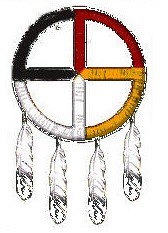2.4 Indigenous Death-Related Beliefs & Practices
A variety of factors make it challenging to provide a brief overview of traditional death-related beliefs and practices among Indigenous peoples in Canada. These factors include: the diversity among Indigenous peoples; the use of oral traditions to share histories and pass on knowledge; and the impact of colonization on traditional cultural and spiritual beliefs and ways of knowing.
Diversity
Indigenous peoples have inhabited what is known as North America and Canada for tens of thousands of years, long before colonization (Stolen Lives, 2015). Today, within the geographic boundaries of Canada, there are three main Indigenous groups, as defined by the Indian Act (1985) and the Constitution of Canada (1982), First Nations, Inuit, and Métis (OECD, 2020; Canada, 2022a; Canada, 2022b). These three groups include more than 50 distinct Indigenous nations, comprising over 630 groups or bands, and over 60 languages (Hunter Crouse, 2020; IWGIA, 2021; OECD, 2020). There is much cultural and spiritual diversity across Indigenous peoples (Anderson & Woticky, 2018; Hunter Crouse, 2020) with traditional “beliefs, values and practices, [vary[ing] widely…over thousands of years” (Kinsella et al., n.d, p. 247). This includes death-related beliefs and practices (Anderson & Woticky, 2018; Muzyka, 2020; NCTR, 2020).
Oral Traditions & Knowledge Sharing
Traditional Indigenous knowledges, and cultural and spiritual practices are passed down orally from one generation to the next within each community via storytelling, dances, performances, songs, and art (AHS, 2016; United Nations, 2019; Indigenous Foundations, 2009). Oral traditions are the foundation of Indigenous societies, “connecting speaker with listener in communal experience and uniting past and present in memory” (Indigenous Foundations, 2009, para. 2). Despite the diversity among Indigenous peoples, there is a common traditional spirituality “rooted in their connection to nature, the earth, and one another” (Kinsella et al., n.d., p. 247) and in the recognition of death as part of the circle of life (Anderson & Woticky, 2018).
VIDEO: The Value of Ceremonies for Family Members
In the following video, Richard Cardinal talks about how the ceremonies at the end of life help complete the circle of life and promote healing for the bereaved.

The cycle of life reflects the belief that “birth and death are inextricably linked as a transition of the spirit through this world” (Anderson & Woticky, 2018, p. 51). For example, according to Longboat (2002:5), the Anishinaabe (Ojibway) perspective on life and death is that “in order to understand death, one must first embrace the cycle of life… with birth, life, death, and the afterlife…[being] four stages of the human spirit.” Representations of the cycle of life, such as the medicine wheel, provides a way of interpreting life and death beyond the physical and into the spirit realm (Anderson & Woticky, 2018; Hampton, et al., 2010), where spirits are believed to live on (Anderson & Woticky, 2018; Duggleby, 2015; TribalTradeCo, 2020). The focus of many traditional Indigenous end-of-life rituals is on healing the spirit and preparing it for its journey to the spirit world (Anderson & Woticky, 2018; Duggleby, et al., 2015).
VIDEO: What is the Medicine Wheel?
In the following video, Mallory Graham from TribalTradeCo.com explains the medicine wheel and why it is so important to Indigenous cultures (Watch to 3:30 minute mark).
Colonization
Ever since the arrival of settlers from European nations and the colonization of North America, Indigenous peoples’ ways of life, their cultural and spiritual views and practices and their lives have been increasingly threatened through forced conversion to Christianity; genocide and cultural genocide that occurred in the Residential School system; the banning of traditional practices, and more (See Chapter on Genocide) (TRC, 2015). Efforts to force Christianity on Indigenous peoples to supplant their traditional spiritual beliefs and cultural practices, negatively impacted oral transmission of knowledge, while significantly altering spiritual belief systems (Hunter Crouse, 2020; Kinsella, et al., n.d; Muzyka, 2020). For some Indigenous peoples, forced Christianity has overwritten and almost completely replaced traditional cultural practices. For others, it has resulted in a combining of spiritual practices, “a fusion” of traditional Indigenous beliefs and Christianity (Murray, 2015). In other communities, there is a growing revitalization and embracing of traditional Indigenous beliefs and practices (Kinsella, et al., n.d.).
Traditional Practices
In the following short videos, members of First Nations, Inuit and Métis communities talk about some of their traditional death-related beliefs and practices, including ceremonies they perform for the dead. This brief exploration of the present-day use of traditional Indigenous death-related beliefs and practices, provides a bridge to the next chapter on Cultural and Religious Beliefs and Death-Related Practices.
VIDEO: Grief and Celebration
In the following video Jim Tuttauk talks about grief after loss, as well as how a person’s death impacts and is mourned by the entire community.
VIDEO: Moving to the Spirit World
In the following video Elaine Lavallee talks about traditional death-related ceremonies that help loved ones move on to the spirit world.
VIDEO: The Comfort of Ceremonies
In the following video Curtis Delorme talks about the comfort and clarity he experiences from participating in traditional after-death ceremonies.
Optional Material
Click the following link to learn more about the diversity of Indigenous death-related customs and beliefs (Optional reading):
Indigenous Perspective on Death and Dying
VIDEO: Indigenous Religions of Canada
To learn more about the diversity of Indigenous customs and beliefs, as well as the impact of colonization, watch the following video (Optional viewing).

